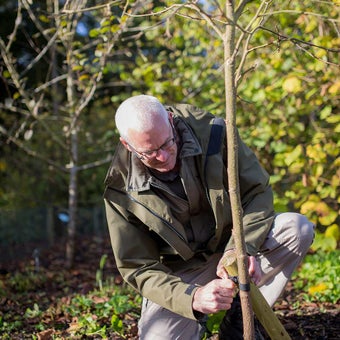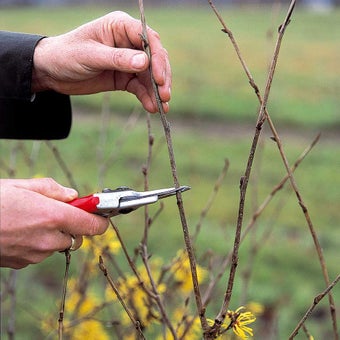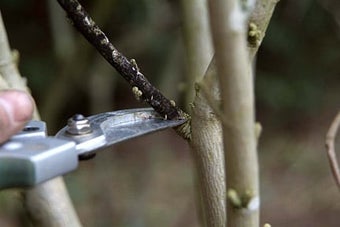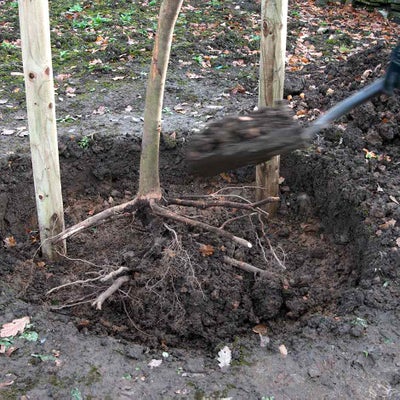
Quick facts
Suitable for - All trees and shrubs
Timing - October to April
Difficulty - Moderate
Suitable for...
This advice is suitable for all trees and shrubs, whether containerised, or rootballed.
For larger plants see our page on buying and planting specimens.
When to plant trees and shrubs
Planting is best done between October and April. Avoid planting in (water sitting on the soil surface or pooled in the bottom of the hole) or frozen (too hard to get the spade in) soil.
Container-grown plants can be planted any time of the year, but are easier to care for if planted in autumn or winter, as they need less watering than ones planted in spring or summer.
and rootballed trees and shrubs are only available in autumn and winter. They should be planted immediately, but if this is not possible, then they can be heeled in (temporary planting in the soil to prevent the roots drying out) until planting is possible.
Masterclass: Trees | Pt.2 Planting
How to plant a tree or large shrub
Site preparation
Plants will not grow where soil contains too little air or where soil moisture is either excessive or insufficient. Pre-planting soil preparation should aim to improve these conditions:
- Loosen the soil to a depth equivalent to the height of the and over a wide area to eliminate compaction and improve drainage
- There is little evidence that adding extra organic matter to the bottom of the planting hole helps; in fact this practice can hinder plant establishment as the organic matter decomposes and may cause the plant to sink.
- It is not beneficial to apply fertiliser at planting time. However, on poor soils sprinkling an inoculant of mycorrhizal fungi (e.g. Rootgrow) over and in contact with the roots, may help trees and shrubs establish
- If soils are waterlogged over winter consider trees better suited to wet soil, install drainage, or plant on a slight mound, about 25-30cm (10in-1ft) high and 1m (39in) in diameter
Guide to planting
- Remove plants from containers or fabric wrapping (some specimen trees specify that the wrapping be left on under the terms of their guarantee, but normally fabric wrappings should be taken off).
- With the exception of magnolia and eucalyptus which resent root disturbance, trim potbound roots and spread the roots out of plants to get an idea of their spread. There is no need to trim or tease out roots from rootballs that are not potbound.
- Dig a planting hole that is no deeper than the roots, but is ideally at least three times the diameter of the root system.
- If the sides of the planting hole are compacted, break the soil up with a fork before planting.
- In grassed areas circular planting holes are easier to mow around, but square planting holes aid root penetration at the corners on heavy soils. A square hole within a mowing circle combines the two.
- Soak bare-rooted trees or shrubs for about 30 minutes prior to planting. And give containerised plants a good water before taking them out of their pots.
- Place the tree or shrub in the planting hole and position it so that the first flare of roots are level with the soil surface when planting is complete. With container-grown plants, the top layers of may need to be scraped away to reveal the flare of roots. Deep planting prevents essential air movement to the root system and makes the lower trunk vulnerable to disease - this can lead to poor establishment.
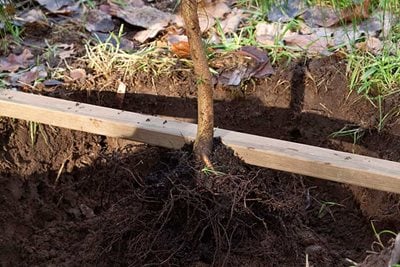
- Insert a stake if required. Small trees do not require staking but top-heavy or larger specimens should be staked.
- Refill the planting hole carefully, placing soil between and around all the roots to eliminate air pockets.
- Firm the soil gently, avoiding compacting the soil into a hard mass and water in.
- Protect from deer or rabbit damage where necessary by using tree spirals, chicken wire guards or similar.
Video step-by-step on how to plant a shrub in your garden
RHS Horticulturist Jack Aldridge demonstrates the step-by-step process of planting a shrub
Aftercare
Watering
Drought stress is common with newly planted trees and shrubs. Even in a cool, wet summer, the rain rarely replenishes soil moisture stores fully. The soil may be dry around the roots even when the surface appears moist.
Dry, windy conditions are especially likely to lead to water shortages. With experience, it is possible to detect the dull, lifeless foliage indicative of drought stress but by then the tree has already been damaged. Ideally anticipate water loss, and irrigate to prevent damage.
Watering aids can assist watering of newly planted trees such as irrigation tubes ( tree irrigation pipe made from potato starch is available) or watering bags such as Treegator®.
Overwatering is possible, especially on poor draining soils and with automatic irrigation systems, which leads to rotting roots and symptoms similar to drought. If in doubt dig down with a trowel to the side of the to see if the soil is beginning to dry before watering. The quantity required will vary with soil type but typically 30-50 litres per square metre (4-6 watering cans) each week in dry weather during the will be necessary.
Weeding and mulching
Weeds, lawns and other vegetation intercept water before it reaches the roots of newly planted trees and shrubs.
- Keep a vegetation-free circle at least 1.2m (4ft) in diameter around the plant for its first three years to help avoid this problem
- The circle can be kept weed free by , hand-weeding, using a mat or other non-chemical control methods
- Laying mulch over this circle is also helpful, although take care to leave a collar of 10cm (4in) around the woody stems that is free of , to prevent the risk of rotting the
Feeding
Fertilisers do not need to be added at planting time but can be used a season after planting if the soil is very poor or a boost to growth is required. However, if you are using a mycorrhizal fungi (e.g. Rootgrow) do not to apply a fertiliser at all as phosphorus (found in general fertilisers and superphosphate) can suppress the fungus.
Formative pruning
Corrective pruning on misshapen trees is best carried out while the tree is still young. This may involve shortening or removing any competing leaders and removing damaged, dead or diseased wood. Lower laterals (i.e. sideshoots coming off the main trunk) may also need removing in stages over the first few years if a clear trunk is desirable. See our page on formative pruning of new trees.
Adjusting ties and removing stakes
Inspect tree ties in spring and autumn and adjust ties to prevent constriction of the stem. After two growing seasons the tree should make sufficient root growth to anchor the tree and the stake can be removed.
Masterclass: Trees | Pt.3 Aftercare
Problems
Planting too deep is a common cause of tree death. Poor establishment, brown leaves or general leaf damage are also sometimes encountered after planting.
Newly planted trees often need protection from mice and voles, rabbits and deer to prevent being ring-barked.


